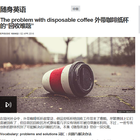
外带咖啡纸杯的回收难题
介绍: Vocabulary: problems and solutions 词汇:问题与解决办法
Millions of us grab a coffee on our way to work. And when we do, it probably comes served in a branded, disposable, cardboard coffee cup. Once the coffee is done, just pop the cup into a recycling bin and forget about it. The cup will be taken away and t...
介绍: Vocabulary: problems and solutions 词汇:问题与解决办法
Millions of us grab a coffee on our way to work. And when we do, it probably comes served in a branded, disposable, cardboard coffee cup. Once the coffee is done, just pop the cup into a recycling bin and forget about it. The cup will be taken away and turned into a new one for you to use again tomorrow. The system works, right?
There’s a hitch. In the UK, we throw away an estimated 2.5 billion disposable coffee cups every year. And despite being recyclable in theory, in practice only very few of them are dealt with in a way that makes them sustainable. This makes them a bit of an obstacle. What throws a spanner in the works is the layer of polyethylene that makes the cup waterproof, and the lid, which is most often made of polystyrene. As a result, most of the cups end up in landfill.
But there are efforts underway to tackle this issue. One company, Biome Bioplastics, has come up with a fully compostable, recyclable cup that uses natural materials, such as potato starch, as waterproofing. Mr Mines, its chief executive, believes that this is the first time bioplastic has been used for disposable cups and lids that have to cope with hot liquid. And they're still fully recyclable.
Another feasible solution has been proposed by Frugalpac, who have patented a cup with a lightly-attached plastic lining. This can be easily separated during the recycling and ‘offers a more pragmatic solution' than changing our current recycling habits, says Frugalpac’s founder Martin Myerscough.
Safia Qureshi says India has provided the inspiration for her solution. She puts forward that we use returnable and reusable cups, which are tracked and collected by her company Cup Club. They will be responsible for collecting, washing and redistributing the clean cups to participating retailers.
One final example of lateral thinking comes from Cupffee. This trio from Bulgaria have combined cereals to form a cup which can be eaten once the drink is finished. It is apparently sweet and crisp, can hold a coffee for up to 40 minutes and will biodegrade within weeks.
Whether any of these innovative ideas are a perfect fit for this disposable issue, only time will tell. It’s possible that a more viable solution has yet to be ventured, though it may not be long in coming. All it may require is a little more thinking outside the box… or should that be coffee cup?




